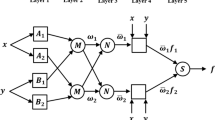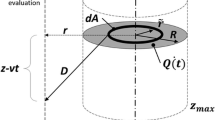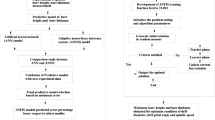Abstract
The thermal injuries increase with temperature elevation during bone drilling that can cause irreversible, permanent death of regenerative bony cells resulting in thermal osteonecrosis. The ascent in temperature during the drilling procedure is a significant concern for every orthopaedic surgeon. Since it is difficult to monitor and predict temperature elevation during real-time in vivo medical surgery, a robust predictive machine-learning (ML) model has been proposed in the present work. Successively, the efficiency of rotary ultrasonic-assisted bone drilling (RUABD) is experimentally verified to reduce thermal injuries during bone drilling. Several rigorous in vitro experiments were performed on pig femur bone with changing independent variables like rotational speed, feedrate, abrasive grit size, and vibrational ultrasonic power during the study. The assumptions for the implementation of machine learning models have been successfully corroborated and validated. The multi-linear regression was compared with a multilayer perceptron, lasso regression, and ridge regression to provide the most accurate predictive models. The accuracy of ML models was observed with different error metrics such as mean absolute error (MAE), root mean square error (RMSE), and mean square error (MSE). The error metrics of ridge regression were comparatively lower with MAE 1.702 ± 0.229, RMSE 2.015 ± 0.398 and MSE 5.214 ± 1.840 than other ML models. The Ridge regression model was able to predict temperature rise during bone drilling with an adequacy of ± 1.7 °C. The prediction of thermal injuries using machine learning models is the key contribution and a proof-of-concept of the present in vitro study.








Similar content being viewed by others
References
Noordin MY, Jiawkok N, Ndaruhadi PYMW, Kurniawan D (2015) Machining of bone: analysis of cutting force and surface roughness by turning process. Proc Inst Mech Eng Part H J Eng Med 229:761–768. https://doi.org/10.1177/0954411915606169
Huiyu H, Chengyong W, Yue Z et al (2017) Investigating bone chip formation in craniotomy. Proc Inst Mech Eng Part H J Eng Med 231:959–974. https://doi.org/10.1177/0954411917727245
Yao Y, Wang L, Li J et al (2020) A novel auxetic structure based bone screw design: Tensile mechanical characterization and pullout fixation strength evaluation. Mater Des 188:108424. https://doi.org/10.1016/j.matdes.2019.108424
Chen J, An Q, Zou F et al (2021) Analysis of low-frequency vibration-assisted bone drilling in reducing thermal injury. Mater Manuf Process 36:27–38. https://doi.org/10.1080/10426914.2020.1813891
Singh RP, Pandey PM, Mridha AR, Joshi T (2020) Experimental investigations and statistical modeling of cutting force and torque in rotary ultrasonic bone drilling of human cadaver bone. Proc Inst Mech Eng Part H J Eng Med 234:148–162. https://doi.org/10.1177/0954411919889913
Gupta V, Pandey PM (2017) In-situ tool wear monitoring and its effects on the performance of porcine cortical bone drilling: a comparative in-vitro investigation. Mech Adv Mater Mod Process 3:1–7. https://doi.org/10.1186/s40759-017-0019-z
Gupta V, Pandey PM, Mridha AR, Gupta RK (2017) Effect of various parameters on the temperature distribution in conventional and diamond coated hollow tool bone drilling: a comparative study. Procedia engineering. Elsevier, pp 90–98
Feldmann A, Ganser P, Nolte L, Zysset P (2017) Orthogonal cutting of cortical bone: Temperature elevation and fracture toughness. Int J Mach Tools Manuf 118–119:1–11. https://doi.org/10.1016/j.ijmachtools.2017.03.009
Jamil M, Rafique S, Khan AM et al (2020) Comprehensive analysis on orthopedic drilling: A state-of-the-art review. Proc. Inst. Mech Eng Part H J Eng Med 234:537–561
Pandey RK, Panda SS (2013) Drilling of bone: a comprehensive review. J Clin Orthop Trauma 4:15–30. https://doi.org/10.1016/j.jcot.2013.01.002
Agarwal R, Gupta V, Singh J (2022) Mechanical and biological behaviour of additive manufactured biomimetic biodegradable orthopaedic cortical screws. Rapid Prototyp J 4:1–25. https://doi.org/10.1108/rpj-01-2022-0006
Agarwal R, Gupta V, Singh J (2022) Additive manufacturing-based design approaches and challenges for orthopaedic bone screws: a state-of-the-art review. J Brazilian Soc Mech Sci Eng 44:1–25. https://doi.org/10.1007/s40430-021-03331-8
Agarwal R, Mehtani HK, Singh J, Gupta V (2022) Post-yielding fracture mechanics of 3D printed polymer-based orthopedic cortical screws. Polym Compos 43:1–9. https://doi.org/10.1002/pc.26620
Gok K, Erdem M, Kisioglu Y et al (2021) Development of bone chip - vacuum system in orthopedic drilling process. J Brazilian Soc Mech Sci Eng 43:1–11. https://doi.org/10.1007/s40430-021-02959-w
Amewoui F, Le Coz G, Bonnet AS, Moufki A (2019) Bone drilling: a thermal model for bone temperature prediction. Comput Methods Biomech Biomed Engin 22:S305–S307. https://doi.org/10.1080/10255842.2020.1714922
Fernandes MGA, Fonseca EMM, Natal RJ (2016) Thermal analysis during bone drilling using rigid polyurethane foams: numerical and experimental methodologies. J Brazilian Soc Mech Sci Eng 38:1855–1863. https://doi.org/10.1007/s40430-016-0560-4
Pandey RK, Panda S (2015) Optimization of bone drilling using Taguchi methodology coupled with fuzzy based desirability function approach. J Intell Manuf 26:1121–1129. https://doi.org/10.1007/s10845-013-0844-9
Akgundogdu A, Jennane R, Aufort G, Benhamou CL (2010) 3D image analysis and artificial intelligence for bone disease classification. J Med Syst 34:815–828. https://doi.org/10.1007/s10916-009-9296-3
Pandey RK, Panda SS (2014) A feasibility investigation for modeling and optimization of temperature in bone drilling using fuzzy logic and Taguchi optimization methodology. Proc Inst Mech Eng Part H J Eng Med 228:1135–1145. https://doi.org/10.1177/0954411914559738
Zahedi E, Khosravian F, Wang W et al (2020) Towards skill transfer via learning-based guidance in human-robot interaction: an application to orthopaedic surgical drilling skill. J Intell Robot Syst 98:667–678. https://doi.org/10.1007/s10846-019-01082-2
Pandey RK, Panda SS (2013) Modeling of temperature in orthopaedic drilling using fuzzy logic. Appl Mech Mater 249:1313–1318. https://doi.org/10.4028/www.scientific.net/AMM.249-250.1313
Lee J, Davari H, Singh J, Pandhare V (2018) Industrial Artificial Intelligence for industry 4. 0-based manufacturing systems. Manuf Lett 18:20–23. https://doi.org/10.1016/j.mfglet.2018.09.002
Lee J, Ni J, Singh J et al (2020) Intelligent maintenance systems and predictive manufacturing. J Manuf Sci Eng. https://doi.org/10.1115/1.4047856
Pandey RK, Panda SS (2013) Predicting temperature in orthopaedic drilling using back propagation neural network. Procedia Eng 51:676–682. https://doi.org/10.1016/j.proeng.2013.01.096
Lu C, Ko EW, Liu L (2009) Improving the video imaging prediction of postsurgical facial profiles with an artificial. J Dent Sci 4:118–129. https://doi.org/10.1016/S1991-7902(09)60017-9
da Silva FB, Corso LL, Costa CA (2021) Optimization of pedicle screw position using finite element method and neural networks. J Brazilian Soc Mech Sci Eng 43:1–7. https://doi.org/10.1007/s40430-021-02880-2
Alam K, Silberschmidt VV (2014) Analysis of temperature in conventional and ultrasonically-assisted drilling of cortical bone with infrared thermography. Technol Heal Care 22:243–252. https://doi.org/10.3233/THC-140813
Gupta V, Singh RP, Pandey PM, Gupta R (2020) In vitro comparison of conventional surgical and rotary ultrasonic bone drilling techniques. Proc Inst Mech Eng Part H J Eng Med 234:398–411. https://doi.org/10.1177/0954411919898301
Shakouri E, Sadeghi MH, Karafi MR et al (2015) An in vitro study of thermal necrosis in ultrasonic-assisted drilling of bone. Proc Inst Mech Eng Part H J Eng Med 229:137–149. https://doi.org/10.1177/0954411915573064
Singh G, Jain V, Gupta D, Sharma A (2018) Parametric effect of vibrational drilling on osteonecrosis and comparative histopathology study with conventional drilling of cortical bone. Proc Inst Mech Eng Part H J Eng Med 232:975–986. https://doi.org/10.1177/0954411918794983
Agarwal R, Gupta V, Jain V (2021) A novel technique of harvesting cortical bone grafts during orthopaedic surgeries. J Brazilian Soc Mech Sci Eng 8:1–14. https://doi.org/10.1007/s40430-021-03064-8
Agarwal R, Jain V, Gupta V et al (2020) Effect of surface topography on pull-out strength of cortical screw after ultrasonic bone drilling: an in vitro study. J Brazilian Soc Mech Sci Eng 42:1–13. https://doi.org/10.1007/s40430-020-02449-5
Gupta V, Pandey PM (2016) Experimental investigation and statistical modeling of temperature rise in rotary ultrasonic bone drilling. Med Eng Phys 38:1330–1338. https://doi.org/10.1016/j.medengphy.2016.08.012
Gupta V, Pandey PM, Gupta RK, Mridha AR (2017) Rotary ultrasonic drilling on bone: A novel technique to put an end to thermal injury to bone. Proc Inst Mech Eng Part H J Eng Med 231:189–196. https://doi.org/10.1177/0954411916688500
Agarwal R, Gupta V, Singh J (2022) A novel drill bit design for reducing bone-chip morphology in orthopaedic bone drilling. In: Materials today: proceedings. Elsevier Ltd, pp 2–7
Alam K, Mitrofanov AV, Silberschmidt VV (2009) Measurements of surface roughness in conventional and ultrasonically assisted bone drilling. Am J Biomed Sci 1:312–320. https://doi.org/10.5099/aj090400312
Singh RP, Pandey PM, Behera C (2020) Effects of rotary ultrasonic bone drilling on cutting force and temperature in the human bones. Proc Inst Mech Eng Part H J Eng Med 234:829–842. https://doi.org/10.1177/0954411920925254
Moayedi H, Foong LK, Nguyen H (2020) Soft computing method for predicting pressure drop reduction in crude oil pipelines based on machine learning methods. J Brazilian Soc Mech Sci Eng 42:1–11. https://doi.org/10.1007/s40430-020-02613-x
Ahmad F, Mat Isa NA, Hussain Z et al (2015) A GA-based feature selection and parameter optimization of an ANN in diagnosing breast cancer. Pattern Anal Appl 18:861–870. https://doi.org/10.1007/s10044-014-0375-9
Zhang F, O’Donnell LJ (2019) Support vector regression. In: Machine learning: methods and applications to brain disorders. Elsevier Inc., pp 123–140
Navarro D (2013) Learning statistics with R: A tutorial for psychology students and other beginners: Version 0.5. In: Lulu press. pp 303–325
Dangeti P (2017) Parallelism of statistics and machine learning. In: Statistics for machine learning. Packt Publishing, pp 55–82
Chen Y, Cheng A, Zhang C et al (2021) Rapid mechanical evaluation of the engine hood based on machine learning. J Brazilian Soc Mech Sci Eng 43:1–17. https://doi.org/10.1007/s40430-021-03070-w
Funding
The present work is financially supported by TIET SEED money grant TU/DORSP/57/7254.
Author information
Authors and Affiliations
Corresponding author
Ethics declarations
Competing interest
None declared.
Additional information
Technical Editor: Zilda de Castro Silveira.
Publisher's Note
Springer Nature remains neutral with regard to jurisdictional claims in published maps and institutional affiliations.
Rights and permissions
About this article
Cite this article
Agarwal, R., Singh, J. & Gupta, V. An intelligent approach to predict thermal injuries during orthopaedic bone drilling using machine learning. J Braz. Soc. Mech. Sci. Eng. 44, 320 (2022). https://doi.org/10.1007/s40430-022-03630-8
Received:
Accepted:
Published:
DOI: https://doi.org/10.1007/s40430-022-03630-8




